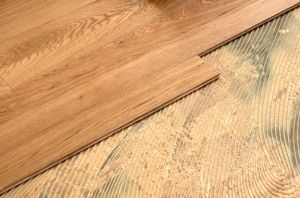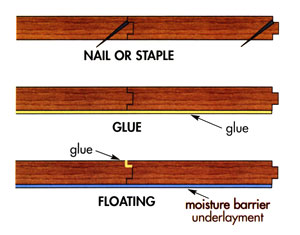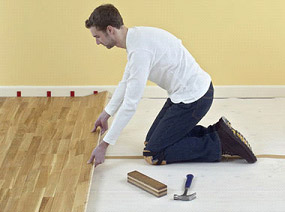We use cookies to make your experience better. To comply with the EU GDPR e-Privacy directive, we need to ask for your consent to set cookies. Learn more.
Wood Floor Installation Techniques - Which One and Why?
 Image courtesy by moderncarpetone.com
Image courtesy by moderncarpetone.com
Different wood floor installation techniques are required for each type of floor. Considering you are already aware of the benefits that wood flooring comprises over other kinds of floors, it is now time to move onto the installation process, and more specifically to the different wood floor installation techniques that you'll need to apply according to each type of floor.
But before we examine the different wood floor installation techniques, it is important to mention that some preparation may need to be done on the sub-floor previously.
Subfloor Preparation:
 Image courtesy by sinfinishline.com
Image courtesy by sinfinishline.com
As it is obvious, prior to installation is to remove all furniture and other objects from the room so you can have a clear visibility of what needs to be done. Since everything is out of the room now, the next step is to ensure that the sub-floor is not wet, as moisture can cause a big damage to your new floor in a short period of time. Keep in mind that the ideal level of humidity within a room when installing a new floor should be between 40-60% and the temperature around 20 degrees. The last step of the preparation process involves extensive cleaning of all traces of debris, dust and dirt from the sub-floor.
Click here if you want to find out more about preparation of concrete subfloors.
If you have installed a wooden sub-floor, click here to find more information about preparation needed.
Choosing a wood floor installation technique:
There are three types of wood floor installation techniques and the two factors that will determine which one to apply are: the type of sub-floor you have and the type of flooring you are planning to install above it.
Types of sub-flooring:
- concrete/cement
- Plywood
- Particle board
- Floor joists
Knowing what type of sub-floor you have, will help you a lot to determine which method to use, how to apply it, and what benefits it will have compare to the other techniques. In most occasions the sub-floor would be either plywood, or concrete.
Wood floor installation techniques:
 Image courtesy by quinnfloors.com
Image courtesy by quinnfloors.com
Glue down - This method is applied when installing engineered wood floors and parquets. It can be carried out upon both wooden and concrete sub-floors and as the name indicates, this technique requires mastic or adhesive, spread directly on to the sub-floor for the boards to be adhered directly to it. It is essential though, that a two part damb proof membrane is always laid if it is to be fitted on a concrete/cement subfloor. This will protect the floor from any moisture coming through the sub-floor and it will also provide a suitable surface for the adhesive to bond to.
As with all three methods, preparation is a key element for a successful result. Glue-down method can provide great stability if it is carried out properly, but it can also cause a lot of problems when the sub-floor is not flat. It is also important that the sub-floor is cleaned before any glue is being spread, as it can lead to improper bonding if it goes over dirt and dust. Additionally, you need to ensure that the right adhesive is being used as there are different options for different applications. Lastly after the installation process is finished, you need to allow some time before you walk on the new floor.
Note: Glue-down method is not suitable for laminate wood-floors. It is highly recommended that this installation is carried out by a professional flooring installer when the sub-floor is not flat.
To find out more about laminate flooring click here
Nail down- - The nail-down technique is the most challenging of the three and it is mainly used when installing solid wood floors. Additionally, it can be also applied with engineered wood floors but is much easier to install them with the glue down method.
Moreover it is obvious that this method can be carried out only when there is a wooden sub-floor, as it is not possible to nail down a solid wood floor into concrete/cement. The fact that solid wood floor is thicker than any other type of floor, makes the use of this method essential, as such floor will be more prone to expansion, contraction and movement and by nailing it down, it will ensure great stability. Thus a glue-down method would be unsuccessful on this instance.
It is advised that a poly-foam underlay is used between the floor and the sub-floor, in order to eliminate any squeaking and provide thermal and noise insulation.
Staples can be also used instead of nails to attach the floor to the sub-floor.
As you understand nail-down method is not recommended for a "do it yourself" project and it is usually carried out by a professional installer.
Floating installation - This is the fastest and easiest installation technique among the three and also the most appropriate if you are thinking to "do it yourself". It is most ideally suited to laminate flooring but in some occasions it can be also applied with engineered wood floors. In addition, floating floor can be installed upon any sub-floor and its main characteristic is stability. This is a very essential element in areas where the climate changes often, as when the floor expands it will expand as one unit.
More detailed, a floating floor is not fixed directly on the sub-floor but is usually installed over a thin underlay, with the floating boards fixed to each other. This can be achieved in two ways: either by spreading water based glue on each of the four sides of every board in order to keep them together, or the boards are manufactured in such way to snap together. This is famous as "click-lock system", where the boards lock together without using additional adhesive.
The underlay will also provide insulation from noise and protect the floor from humidity. It will also make walking and standing on the floor easier and more comfortable, thus it is very important that you invest on a high quality underlay.
Click here to find out more about the benefits of using an underlay.
 image courtesy by studiofloors.com
image courtesy by studiofloors.com
As this article indicates, there are different wood floor installation techniques for different type of floors. Floating method is the easiest one if you want to avoid the installation costs and do it yourself, while glue and nail-down techniques are more demanding (especially nail-down) and need to be carried out by a professional. The most appropriate method for you is depending on the type of sub-floor you have and the type of floor you need to install above it. Lastly, as with everything else in this life, preparation is the key to successful flooring installation.

